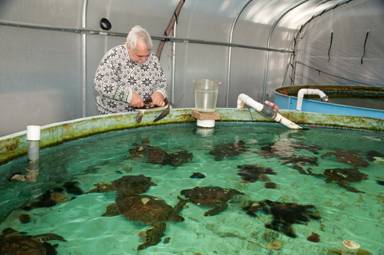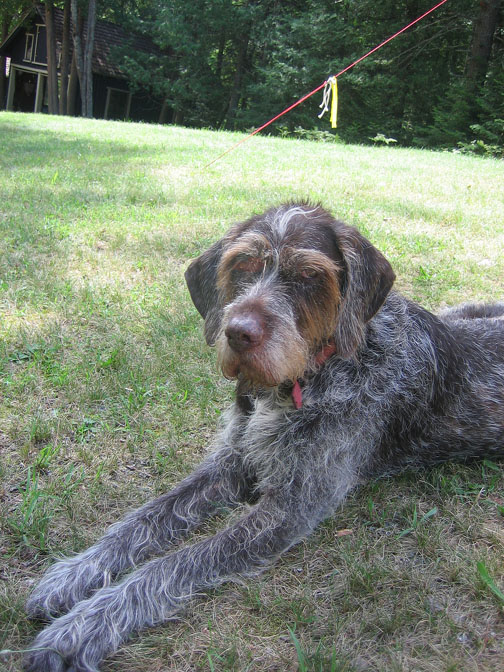More Photos Below!Gallery
Marine labs and aquariums are usually big places, funded by universities and vast enterprises. The Gulf Specimen Lab is the only independent lab on the Gulf Coast. It’s run by Jack Rudloe, the guy who started the conservation movement down there—the only reason why that whole stretch isn’t Disney already. Just one little guy in Panacea, FL. Busses of kids have explored their way through his compound for decades.
What’s more, Jack started his career at the inspiration of his mentor John Steinbeck. Yes, Gulf Specimen is Doc Rickett’s Cannery Row lab come back to life. And it’s run with as much heart and care. As such it’s probably never been awash in funding and it’s been crosswise with the bureaucrats. I note that its neighboring university lab has never stood up for gulf conservation.
Jack is a fiesty fighter. The recession of course has hit em but now they need their biggest, oldest tank to be replaced. If you pitch in, your money goes *100%* to boots-on-the-ground renovation. ZERO overhead.
Our family visited the lab once. You get closer to the critters here than at any other aquarium. Watch your hands! They look you in the eye.
I know that quite a few Michiganders winter down there. Panacea is on the coast just south of Tallahasee. You really need to visit the Lab. Then head west and get some fresh, family-caught seafood at The Oaks on Hwy 98 or in East Point (where the skiffs pull in with their catch beneath the shanty-type restaurants). Appalacha is a dandy, well-preserved small town to hang out in.
Also, I publish Jack’s realistically thrilling novel of small town Florida’s entanglements with drug smuggling.
He’s also written several marine life nonfiction books that got rave national reviews — he’s the preeminent nature writer of the region.
…And totally indie, totally tied in to his community. Locals bring him specimens in buckets…
Here’s the notice I got…
HELP US REPLACE OUR BIGGEST DISPLAY TANK
Funds are urgently needed to replace a major marine education display at Gulf Specimen Marine Laboratory in Panacea, Florida. Until this past month, “C-5” (otherwise known as the “shark tank” was our largest concrete tank
built in 1970. U-Shaped 120 foot long, running around the perimeter of our 20 x 50′ foot building. It held four thousand gallons of sea water, redfish that struck their food like a freight train, triggerfish that stared up at you with doleful eyes and remoras that we sometimes allowed kids to feed by
hand. On YouTube www.youtube.com/gulfspecimen#p/a/u/1/fhoupZ82eKc you can watch kids squealing with delight as nurse sharks splash them during a feeding frenzy.
Our students, volunteers and alumni still recall the arduous back breaking labor of hauling in beach sand by the bucket full, and working through the night building the sub gravel filter system. Some helped erect the pole barn to keep out the rain, others worked on the insulation or the graphics and
signs. Others helped us produce soft-shell crabs for a molting hormone study, working through the night, picking out the blue crabs that shed their shells and freezing them in liquid nitrogen.
After decades of struggling with aging concrete in the tank walls and floor, spending endless hours and money playing “find the leak” our staff had enough. Wakulla County community service workers demolished it with sledge hammers and hauled away 20 tons of concrete rubble.
We are now seeking $40,000 to rebuild the facility and fill the empty space with new and exciting tanks and exhibits. A bioluminescent tank is planned where people can see luminous sea pansies and plankton flash blue fire along
with transparent tubular columns with jellyfish pulsing in the darkness.
Special tanks featuring the “critter of the month” will magnify small and obscure pistol shrimp and sand fleas to show what monsters they are on giant television screens.
The new temperature controlled tanks will give us more room to hold a greater number of endangered sea turtles during cold stun emergencies. This January we kept 65 sea turtles alive of the five thousand stranded by record biting cold until they could be released.
The new facility will also help us provide live baby blue crabs to Operation Migration’s young whooping cranes that are escorted from Wisconsin by ultralight planes to our nearby St. Marks National Wildlife Refuge.
Field Trip Season and thousands of kids are coming. We don’t want to disappoint them with fewer specimens to show. You can see our dream layout on YouTube <https://www.youtube.com/watch?v=tiM0NYwahZs>
www.youtube.com/watch?v=tiM0NYwahZs. It will cost $40,000, but any contribution you can make towards this effort will be greatly appreciated.
If you are not a member of Gulf Specimen Marine Laboratory, please see our website and join: www.gulfspecimen.org/membership.html or phone us at
(850) 984-5297. Send checks to Gulf Specimen Marine Lab, P.O. Box 327, Panacea, Florida 32346. We are a 501 (c) 3 tax exempt educational organization.
Thanks, Jack Rudloe, President
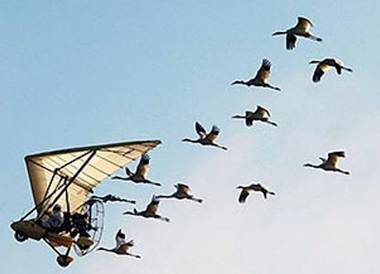
Project Migration cranes coming in!
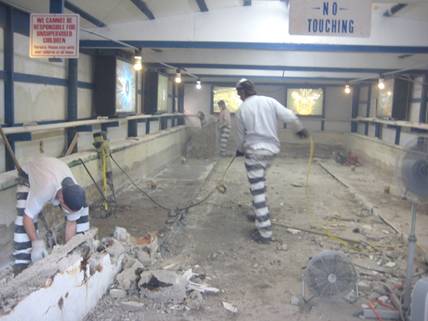
Service workers breaking up the big old tank.
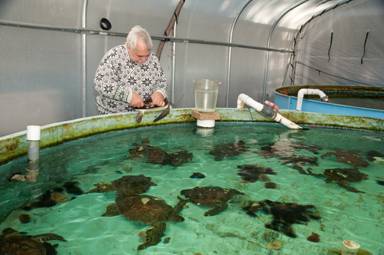
The setting is up close and personal.
